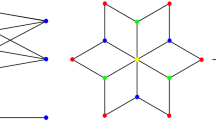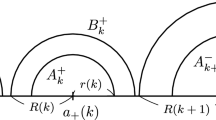Abstract
We consider seven-dimensional unimodular Lie algebras \(\mathfrak {g}\) admitting exact G\(_2\)-structures, focusing our attention on those with vanishing third Betti number \(b_3(\mathfrak {g})\). We discuss some examples, both in the case when \(b_2(\mathfrak {g})\ne 0\), and in the case when the Lie algebra \(\mathfrak {g}\) is (2,3)-trivial, i.e., when both \(b_2(\mathfrak {g})\) and \(b_3(\mathfrak {g})\) vanish. These examples are solvable, as \(b_3(\mathfrak {g})=0\), but they are not strongly unimodular, a necessary condition for the existence of lattices on the simply connected Lie group corresponding to \(\mathfrak {g}\). More generally, we prove that any seven-dimensional (2,3)-trivial strongly unimodular Lie algebra does not admit any exact G\(_2\)-structure. From this, it follows that there are no compact examples of the form \((\Gamma \backslash \mathrm {G},\varphi )\), where \(\mathrm {G}\) is a seven-dimensional simply connected Lie group with (2,3)-trivial Lie algebra, \(\Gamma \subset \mathrm {G}\) is a co-compact discrete subgroup, and \(\varphi \) is an exact \(\mathrm {G}_2\)-structure on \(\Gamma \backslash \mathrm {G}\) induced by a left-invariant one on \(\mathrm {G}\).
Similar content being viewed by others
References
Bonan, E.: Sur les variétés riemanniennes à groupe d’holonomie \(\text{ G }_2\) ou spin\((7)\). C. R. Acad. Sci. Paris 262, 127–129 (1966)
Bryant, R.L.: Metrics with exceptional holonomy. Ann. Math. 126, 525–576 (1987)
Bryant, R.L.: Some remarks on \(\text{ G }_2\)-structures. In: Proceedings of Gökova Geometry–Topology Conference 2005, Gökova Geometry/Topology Conference (GGT), Gökova, pp. 75–109 (2006)
Conti, D., Fernández, M.: Nilmanifolds with a calibrated \(\rm G_2\)-structure. Differ. Geom. Appl. 29, 493–506 (2011)
Diatta, A., Manga, B.: On properties of principal elements of Frobenius Lie algebras. J. Lie Theory 24(3), 849–864 (2014)
Fernández, M.: An example of a compact calibrated manifold associated with the exceptional Lie group \(\text{ G }_2\). J. Differ. Geom. 26(2), 367–370 (1987)
Fernández, M.: A family of compact solvable \(\text{ G }_2\)-calibrated manifolds. Tohoku Math. J. 39(2), 287–289 (1987)
Fernández, M., Fino, A., Kovalev, A., Muñoz, V.: A compact \(\text{ G }_2\)-calibrated manifold with first Betti number \(b_1=1\). arXiv:1808.07144 [math.DG]
Fernández, M., Gray, A.: Riemannian manifolds with structure group \(\text{ G }_2\). Ann. di Mat. Pura Appl. 32, 19–45 (1982)
Fino, A., Raffero, A.: Closed \(\text{ G }_2\)-structures on non-solvable Lie groups. Rev. Mat. Complut. 32(3), 837–851 (2019)
Garland, H.: On the cohomology of lattices in solvable Lie groups. Ann. Math. 84, 174–195 (1966)
Gray, A.: Vector cross products on manifolds. Trans. Amer. Math. Soc. 141, 465–504 (1969)
Hattori, A.: Spectral sequence in the de Rham cohomology of fibre bundles. J. Fac. Sci. Univ. Tokyo Sect. I(8), 289–331 (1960)
Joyce, D.D.: Compact Riemannian 7-manifolds with holonomy \(\text{ G }_2\) I. J. Differ. Geom. 43(II), 291–328 (1996)
Madsen, T.B., Swann, A.: Multi-moment maps. Adv. Math. 229(4), 2287–2309 (2012)
Madsen, T.B., Swann, A.: Closed forms and multi-moment maps. Geom. Dedic. 165, 25–52 (2013)
Milnor, J.: Curvatures of left invariant metrics on Lie groups. Adv. Math. 21(3), 293–329 (1976)
Nomizu, K.: On the cohomology of compact homogeneous spaces of nilpotent Lie groups. Ann. Math. 2(59), 531–538 (1954)
Salamon, S.M.: Complex structures on nilpotent Lie algebras. J. Pure Appl. Algebra 157(2–3), 311–333 (2001)
Acknowledgements
The first author was partially supported by MINECO-FEDER Grant PGC2018-098409-B-100, and Gobierno Vasco Grant IT\(1094-16\), Spain. The second and third author were supported by GNSAGA of INdAM and by the project PRIN 2017 “Real and Complex Manifolds: Topology, Geometry and Holomorphic Dynamics”. The authors are grateful to Thomas Bruun Madsen and Yves Cornulier for useful suggestions and conversations. The second and the third author would like to thank the organizers of the workshop “\(\hbox {G}_2\) manifolds and related topics” (Casa Matemática Oaxaca, May 5–10, 2019), as well as the BIRS and CMO research center.
Author information
Authors and Affiliations
Corresponding author
Additional information
Communicated by Andreas Cap.
Publisher's Note
Springer Nature remains neutral with regard to jurisdictional claims in published maps and institutional affiliations.
Appendix A.
Appendix A.
In this “Appendix”, we explicitly write the matrices associated to the endomorphisms \(A_1, A_2, A_3,\) introduced in the proof of Theorem 2.3, in the case when \(\mathfrak {n}=\mathfrak {n}_{\scriptscriptstyle 1}\) and \(\mathfrak {n}=\mathfrak {n}_{\scriptscriptstyle 2}\). For each of these Lie algebras, we write an ordered basis of the cohomology group \(H^k(\mathfrak {n}^*)\), \(k=1,2,3,\) and the matrix associated to \(A_k\) with respect to that basis. For the sake of convenience, we first impose the conditions on \(D\in {{\,\mathrm{Der}\,}}(\mathfrak {n})\) for which \(\mathfrak {g}= \mathfrak {n}\rtimes _D\mathbb {R}\) is strongly unimodular.
1.1 Case \(\mathfrak {n}=\mathfrak {n}_{\scriptscriptstyle 1}\)
For the Lie algebra \(\mathfrak {n}_{\scriptscriptstyle 1}= \left( 0,0,0,0,e^{12},e^{34}\right) \) with generic derivation \(D_1\) given by (2.2), we have that \(\mathfrak {g}=\mathfrak {n}\rtimes _{D_1}\mathbb {R}\) is strongly unimodular if and only if \(a_8=-a_1-a_4-a_5\). In this case, we get
-
\(H^1(\mathfrak {n}_{\scriptscriptstyle 1}) = \langle [e^1],~[e^2],~[e^3],~[e^4]\rangle \),
$$\begin{aligned} A_1 = -\begin{pmatrix} a_1 &{} a_3 &{} 0 &{} 0 \\ a_2 &{} a_4 &{} 0 &{} 0 \\ 0 &{} 0 &{} a_5 &{} a_7 \\ 0 &{} 0 &{} a_6 &{} -a_1-a_4-a_5 \end{pmatrix}; \end{aligned}$$ -
\(H^2(\mathfrak {n}_{\scriptscriptstyle 1}) = \langle [e^{13}],[e^{14}],[e^{15}], [e^{23}],[e^{24}],[e^{25}],[e^{36}],[e^{46}] \rangle \),
$$\begin{aligned} A_2 = \left( \begin{array}{cccccccccc} -a_1 - a_5 &{} -a_7 &{} -a_{11} &{} -a_3 &{} 0 &{} 0 &{} a_{13} &{} 0 \\ -a_6 &{} a_4 +a_5. &{} -a_{12} &{} 0 &{} -a_3 &{} 0 &{} 0 &{} a_{13} \\ 0 &{} 0 &{} -2 a_1 -a_4 &{} 0 &{} 0 &{} -a_3 &{} 0 &{} 0\\ -a_2 &{} 0 &{} 0 &{} -a_4 -a_5 &{} -a_7 &{} -a_{11} &{} a_{14} &{} 0\\ 0 &{} -a_2 &{} 0 &{} -a_6 &{}a _1 +a_5 &{} -a_{12} &{} 0 &{} a_{14} \\ 0 &{} 0 &{} -a_2 &{} 0 &{} 0 &{} -2 a_4 -a_1 &{} 0 &{} 0\\ 0 &{} 0 &{} 0&{} 0 &{} 0&{} 0 &{} a_1+a_4 -a_5 &{} -a_7 \\ 0 &{} 0 &{} 0 &{} 0&{} 0 &{} 0 &{} -a_6 &{} 2 a_4 +2 a_1 +a_5 \end{array}\right) ; \end{aligned}$$ -
\(H^3(\mathfrak {n}_{\scriptscriptstyle 1}) = \langle [e^{125}], [e^{135}], [e^{136}], [e^{145}], [e^{146}], [e^{235}], [e^{236}], [e^{245}], [e^{246}], [e^{346}] \rangle \),
$$\begin{aligned} A_3 =\left( \begin{array}{ccccccccccc} 2 a_4 +2 a_1 &{} 0&{} 0 &{} 0 &{} 0 &{} 0 &{} 0 &{} 0 &{} 0 &{} 0\\ 0 &{} 2 a_1 +a_5 +a_4 &{} 0 &{} a_6 &{} 0 &{} a_2 &{} 0 &{} 0 &{} 0 &{} 0\\ 0 &{} 0 &{} a_5 {-}a_4 &{} 0 &{} a_6 &{} 0 &{} a_2 &{} 0 &{} 0 &{} 0\\ 0 &{} a_7 &{} 0 &{} a_1 {-}a_5 &{} 0 &{} 0 &{} 0 &{} a_2 &{} 0 &{} 0\\ 0 &{} 0 &{} a_7 &{} 0 &{} {-}2 a_4 {-}a_5 {-}a_1 &{} 0 &{} 0 &{} 0 &{} a_2 &{} 0\\ 0 &{} a_3 &{} 0 &{} 0 &{} 0 &{} 2 a_4 +a_5 +a_1 &{} 0 &{} a_6 &{} 0 &{} 0\\ 0 &{} 0 &{} a_3 &{} 0 &{} 0 &{} 0 &{} a_5 {-}a_1 &{} 0 &{} a_6 &{} 0\\ 0 &{} 0&{} 0 &{} a_3 &{} 0 &{} a_7 &{} 0 &{} a_4 {-}a_5 &{} 0&{} 0\\ 0 &{} 0 &{} 0 &{} 0 &{} a_3 &{} 0 &{} a_7 &{} 0 &{} {-}2 a_1 {-}a_5 {-}a_4 &{} 0\\ 0 &{} 0 &{} 0 &{} 0 &{} 0 &{} 0 &{} 0 &{} 0 &{} 0 &{} {-}2 a_4 {-}2 a_1 \end{array}\right) . \end{aligned}$$
1.2 Case \(\mathfrak {n}=\mathfrak {n}_{\scriptscriptstyle 2}\)
Consider the Lie algebra \(\mathfrak {n}_{\scriptscriptstyle 2}=\left( 0,0,0,0,e^{13}-e^{24},e^{14}+e^{23}\right) \) with generic derivation \(D_2\) given by (2.3). Then, \(\mathfrak {g}=\mathfrak {n}_{\scriptscriptstyle 2}\rtimes _{D_2}\mathbb {R}\) is strongly unimodular if and only if \(a_7=-a_1\). In this case, we have
-
\(H^1(\mathfrak {n}_{\scriptscriptstyle 2}) = \langle [e^1],~[e^2],~[e^3],~[e^4] \rangle \),
$$\begin{aligned} A_1 = \begin{pmatrix} -a_1 &{} a_2 &{} -a_5 &{} a_6\\ -a_2 &{} -a_1 &{} -a_6 &{} -a_5\\ -a_3 &{} a_4 &{} a_1 &{} a_8\\ -a_4 &{} -a_3 &{} -a_8 &{} a_1 \end{pmatrix}; \end{aligned}$$ -
\(H^2(\mathfrak {n}_{\scriptscriptstyle 2}) = \langle [e^{12}], [e^{34}], [e^{13}+e^{24}], [e^{14}-e^{23}], [e^{16}+e^{25}], [-e^{15}+e^{26}], [e^{36}+e^{45}], [-e^{35}+e^{46}] \rangle \),
$$\begin{aligned} A_2 =\left( \begin{array}{cccccccccc} -2 a_1&{} -2 a_6 &{} -2 a_5 &{} a_9-a_{14} &{} a_{10}+a_{13} &{} 0 &{} 0 &{} 0\\ a_4 &{} 0 &{} a_8-a_2 &{} - \frac{1}{2} a_{15} &{} \frac{1}{2} a_{11}- \frac{1}{2} a_{16} &{} -a_6 &{} \frac{1}{2} a_{13}+ \frac{1}{2} a_{10} &{} - \frac{1}{2} a_{9}+ \frac{1}{2} a_{14}\\ -a_3 &{} a_2-a_8 &{} 0 &{} - \frac{1}{2} a_{16} &{} \frac{1}{2} a_{12}+ \frac{1}{2} a_{15} &{} -a[ _5 &{} - \frac{1}{2} a_{14}+ \frac{1}{2} a_9 &{} \frac{1}{2} a_{13}+ \frac{1}{2} a_{10}\\ 0 &{} &{} 0 &{} -a_1 &{} a_8+2 a_2 &{} 0 &{} -a_5 &{} a_6\\ 0 &{} 0 &{} 0 &{} -a_8-2 a_2 &{} -a_1 &{} 0 &{} -a_6 &{} -a_5\\ 0 &{} 2 a_4 &{} -2 a_3 &{} 0 &{} 0 &{} 2 a_1 &{} a_{11} -a_{16} &{} a_{12} +a_{15}\\ 0 &{} 0 &{} 0 &{} -a_3 &{} a_4 &{} 0 &{} a_1 &{} a_2 +2 a_8\\ 0 &{} 0 &{} 0 &{} -a_4 &{} -a_3 &{} 0 &{} -a_2 -2 a_8 &{} a_1 \end{array}\right) ; \end{aligned}$$ -
\(H^3(\mathfrak {n}_{\scriptscriptstyle 2}) = \langle [e^{125}], [e^{126}], [e^{345}], [e^{346}], [-e^{135}+e^{146}], [-e^{135}+e^{236}], [e^{135}+e^{245}], [e^{136}+e^{246}], [e^{145}-e^{246}], [e^{235}-e^{246}] \rangle \),
$$\begin{aligned} A_3 = \left( \begin{array}{cccccccccc} -2 a_1 &{} 0&{} 0 &{} -a_4 &{} -a_4&{} 0 &{} -a_3 &{} 0 &{} -a_4 &{} a_2+a_8\\ 0 &{} -2a_1 &{} -a_2-a_8 &{} a_5 &{} -a_6 &{} -2 a_5 &{} -a_6 &{} 2 a_6 &{} -a_5 &{} 0\\ 0 &{} a_2+a_8 &{} 2 a_1&{} a_6 &{} a_5&{} 0 &{} -a_5 &{} 0 &{} -a_6 &{} 0\\ a_6 &{} 0 &{} a_4&{} 0 &{} -a_2 -2 a_8 &{} 0 &{} -a_8 -2 a_2 &{} a_2+a_8&{} 0 &{} 0\\ a_5&{} 0 &{} a_3 &{} a_2+2a_8 &{} 0 &{} -a_2-a_8&{} 0 &{} 0 &{} -a_8-2 a_2 &{} 0\\ 0 &{} -a_3 &{} 0 &{} 0 &{} -a_2&{} 0 &{} -a_8 -2 a_2 &{} a_2-a_8 &{} 0 &{} -a_5\\ -a_5 &{} 0 &{} -a_3&{} a_2 &{} 0 &{} a_2+a_8 &{} 0 &{} 0 &{} -a_8 &{} 0\\ 0 &{} -a_4 &{} 0 &{} a_2 &{} 0 &{} -a_2+a_8 &{} 0 &{} 0 &{} -a_8 -2 a_2 &{} a_6\\ -a_6 &{} 0 &{} a_4 &{} 0 &{} a_2 &{} 0 &{} a_8 &{} a_2+a_8&{} 0 &{} 0\\ -a_2-a_8 &{} 0 &{} 0 &{} a_3 &{} a_3 &{} -2 a_3 &{} a_4&{} -2 a_4 &{} -a_3 &{} -2 a_1 \end{array}\right) . \end{aligned}$$
Rights and permissions
About this article
Cite this article
Fernández, M., Fino, A. & Raffero, A. Exact \(\hbox {G}_{2}\)-structures on unimodular Lie algebras. Monatsh Math 193, 47–60 (2020). https://doi.org/10.1007/s00605-020-01429-0
Received:
Accepted:
Published:
Issue Date:
DOI: https://doi.org/10.1007/s00605-020-01429-0




